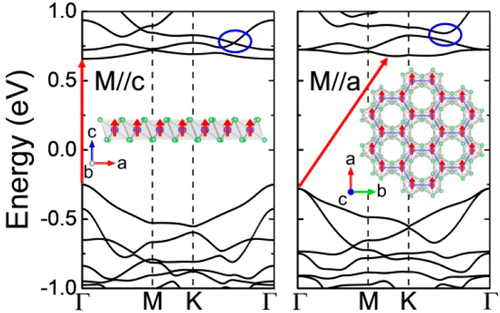当前位置:
X-MOL 学术
›
Nano Lett.
›
论文详情
Our official English website, www.x-mol.net, welcomes your feedback! (Note: you will need to create a separate account there.)
Spin Direction-Controlled Electronic Band Structure in Two-Dimensional Ferromagnetic CrI3
Nano Letters ( IF 9.6 ) Pub Date : 2018-05-22 00:00:00 , DOI: 10.1021/acs.nanolett.8b01125 Peiheng Jiang 1 , Lei Li 1 , Zhaoliang Liao 2 , Y. X. Zhao 3, 4 , Zhicheng Zhong 1
Nano Letters ( IF 9.6 ) Pub Date : 2018-05-22 00:00:00 , DOI: 10.1021/acs.nanolett.8b01125 Peiheng Jiang 1 , Lei Li 1 , Zhaoliang Liao 2 , Y. X. Zhao 3, 4 , Zhicheng Zhong 1
Affiliation

|
Manipulating physical properties using the spin degree of freedom constitutes a major part of modern condensed matter physics and is a key aspect for spintronics devices. Using the newly discovered two-dimensional van der Waals ferromagnetic CrI3 as a prototype material, we theoretically demonstrated a giant magneto band-structure (GMB) effect whereby a change of magnetization direction significantly modifies the electronic band structure. Our density functional theory calculations and model analysis reveal that rotating the magnetic moment of CrI3 from out-of-plane to in-plane causes a direct-to-indirect bandgap transition, inducing a magnetic field controlled photoluminescence. Moreover, our results show a significant change of Fermi surface with different magnetization directions, giving rise to giant anisotropic magnetoresistance. Additionally, the spin reorientation is found to modify the topological states. Given that a variety of properties are determined by band structures, our predicted GMB effect in CrI3 opens a new paradigm for spintronics applications.
中文翻译:

二维铁磁CrI 3中自旋方向控制的电子能带结构
利用自旋自由度操纵物理性质是现代凝聚态物理的重要组成部分,并且是自旋电子器件的关键方面。使用新发现的二维范德华力铁磁CrI 3作为原型材料,我们从理论上证明了巨大的磁带结构(GMB)效应,其中磁化方向的变化极大地改变了电子带结构。我们的密度泛函理论计算和模型分析表明,旋转CrI 3的磁矩从平面外到平面内的光会引起直接到间接的带隙跃迁,从而引起磁场控制的光致发光。此外,我们的结果表明费米表面在不同的磁化方向上发生了显着变化,从而产生了巨大的各向异性磁阻。另外,发现自旋重新取向可以改变拓扑状态。考虑到能带结构决定了各种性质,我们在CrI 3中预测的GMB效应为自旋电子学应用开辟了新的范例。
更新日期:2018-05-22
中文翻译:

二维铁磁CrI 3中自旋方向控制的电子能带结构
利用自旋自由度操纵物理性质是现代凝聚态物理的重要组成部分,并且是自旋电子器件的关键方面。使用新发现的二维范德华力铁磁CrI 3作为原型材料,我们从理论上证明了巨大的磁带结构(GMB)效应,其中磁化方向的变化极大地改变了电子带结构。我们的密度泛函理论计算和模型分析表明,旋转CrI 3的磁矩从平面外到平面内的光会引起直接到间接的带隙跃迁,从而引起磁场控制的光致发光。此外,我们的结果表明费米表面在不同的磁化方向上发生了显着变化,从而产生了巨大的各向异性磁阻。另外,发现自旋重新取向可以改变拓扑状态。考虑到能带结构决定了各种性质,我们在CrI 3中预测的GMB效应为自旋电子学应用开辟了新的范例。









































 京公网安备 11010802027423号
京公网安备 11010802027423号